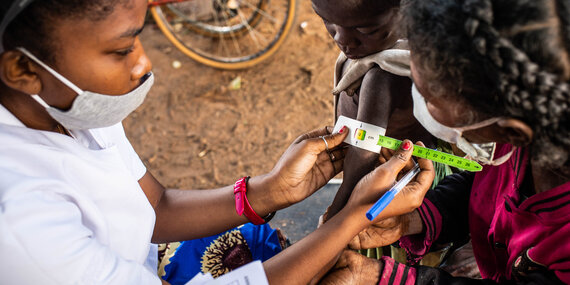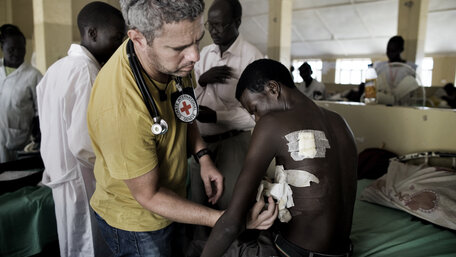Etakaky, Madagascar
A child is screened for malnutrition measuring the upper arm circumference by a mobile clinic in Etakaky, Ampanihy District. The number of children admitted for treatment for life-threatening severe acute malnutrition in the Grand Sud in the first quarter of 2021 was quadruple the five-year average. People in Madagascar’s Grand Sud are facing the region’s most acute drought since 1981, leading to a severe humanitarian crisis. OCHA/Viviane Rakotoarivony
Last year’s warnings of unprecedented levels of global food insecurity have been confirmed. Up to 811 million people worldwide were undernourished in 2020, an approximate rise of 161 million from the previous year.
In 2021, the situation continued to deteriorate. Acute hunger levels and famine-like conditions were driven by a toxic combination of factors including conflict, the impacts of COVID-19, extreme weather and climate shocks, transboundary pests and difficulties reaching people in need. In 2021, overlapping and compounding drivers have come together to form a perfect storm. The impacts of each of these converging catastrophes are disproportionately felt by women and girls – who account for 60 per cent of people who are chronically food insecure globally. In nearly two thirds of countries, women are more likely than men to report food insecurity. Women farmers are also at particular risk of hunger, and face greater barriers to accessing land, agricultural inputs and credit.
In its September update, the Global Report on Food Crises (a joint, consensus-based analysis by 16 partner organizations) estimated that 161 million people in 42 countries faced acute food insecurity in the first eight months of 2021. However, given the worsening situation at the end of 2021, and the fact that IPC/CH or equivalent analyses do not cover all the countries at risk, if additional contexts are factored in, the numbers are likely to be even higher; up to 283 million people could be acutely food insecure or at high risk in 2021 across 80 countries. This is a record high, and an unprecedented increase of 12.4 million people since the June 2021 edition of WFP’s Global Operational Response Plan was published.
This increase is primarily driven by new food insecurity figures from Afghanistan, Myanmar and Somalia. Meanwhile, famine-like conditions remain a real and terrifying possibility in 43 countries around the world, with 45 million people facing emergency or catastrophic levels of acute food insecurity in IPC Phase 4 Emergency and above, up from 41 million people in June 2021. This includes 584,000 people facing famine-like conditions in Ethiopia, Madagascar, South Sudan and Yemen. The situation also remains extremely concerning in Nigeria, where areas in the conflict-affected north-east may be at risk of famine should the situation deteriorate further.
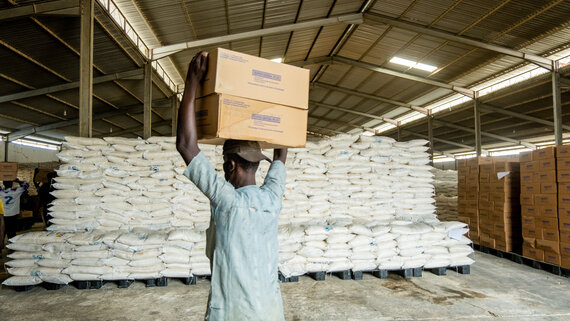
Maiduguri, Nigeria
A worker offloads food provisions in WFP’s warehouse in Maiduguri. Humanitarian partners work around the clock to provide food access for the most vulnerable communities affected by violence and food insecurity across Nigeria.
OCHA/Damilola OnafuwaAs conflict spreads across northern Ethiopia, the impact is devastating. At least 5.5 million people across three regions – Afar, Amhara and Tigray – were in crisis levels of acute food insecurity and in dire need of food assistance in mid-2021, with 2 million people facing emergency levels of acute food insecurity. Up to 401,000 people were projected to be in IPC Phase 5 Catastrophe in 2021 – the highest number since the 2011 famine in Somalia – due to the impact of conflict in the northern Ethiopia region. The situation is also worrying in other parts of the country: overall, an estimated 16.8 million people were facing crisis levels of acute food insecurity in 2021 in Ethiopia.
In 2021, Afghanistan became one of the world’s largest hunger crises. Acute food insecurity is affecting 22.8 million people (more than half the population). This figure includes 8.7 million people facing emergency levels of food insecurity (IPC Phase 4). Among those at risk are 3.2 million children under 5 years of age who are expected to suffer from acute malnutrition by the year’s end.
Over half (16.2 million) of Yemen’s population is facing crisis-levels of acute food insecurity, with 5 million people facing Emergency IPC Phase 4. In South Sudan, humanitarian needs are outpacing the resources available to respond, and the situation has worsened as the country is battered by flooding that has swallowed entire villages. Acute food insecurity of crisis level (IPC Phase 3 or above) affects 7.2 million people. More than 2.4 million of those people are in Emergency IPC Phase 4, and more than 108,000 face catastrophic (IPC Phase 5) levels of hunger.
Food insecurity levels (2021)
Almost half of the people living in CAR experience high acute food insecurity, with thousands of children and women severely malnourished due to factors such as the socioeconomic effects of the COVID-19 pandemic. Around 27 million people in the Democratic Republic of Congo (DRC) are experiencing high levels of acute food insecurity (IPC Phase 3 or above) between September and December 2021. Of these, around 6.1 million people are experiencing critical levels of acute food insecurity (IPC Phase 4). DRC has the world’s largest number of highly food insecure people. Some 12.4 million people in Syria do not know where their next meal will come from – a level of food insecurity higher than any time during the country’s decade-long conflict. Approximately 3.5 million people in Somalia faced high acute food insecurity in late 2021, with 1.2 million children likely acutely malnourished.
The Central Sahel (Burkina Faso, Mali and Niger) experienced a record level of violence in 2020, driving the number of IDPs up from 1.8 million in September 2020 to 2.3 million in September 2021. At the same time, food insecurity has increased, with the number of people in food crisis or worse more than doubling between 2019 and 2020.
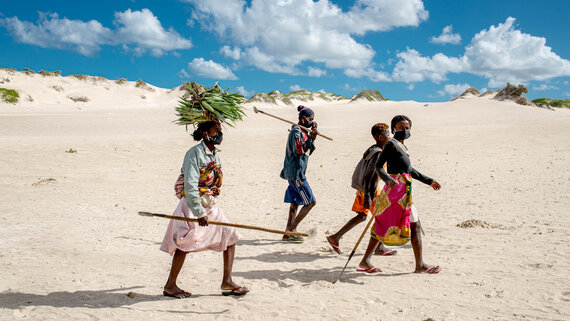
Anjampaly, Madagascar
Sand dunes are restored in Anjampaly, Madagascar, through a UNDP project that helps provide cash for work, income for local communities and protection for sand-covered crop fields. Between November 2020 and January 2021, the Grand Sud received less than 50 per cent of the normal rainfall, leading to the region’s most acute drought since 1981. Extreme drought affected almost 69 per cent of the Grand Sud. Sandstorms, soil erosion and deforestation have transformed arable land into wasteland across wide areas in the region.
OCHA/Viviane RakotoarivonyConflict remains the key driver of food insecurity. Close to 100 million people experienced acute hunger across 23 countries affected by conflict and insecurity in 2020, and protracted conflict was the main cause of six of the ten worst food crises. In 2020, 56 armed conflicts were active around the world — the highest number recorded since the end of the Second World War — and fatalities caused by organized violence increased for the first time in six years.
While data for 2021 is not yet available, key trends indicate that conflict continues to be the primary driver of an alarming rise of food insecurity, particularly among refugees and the most vulnerable. In 2021, conflict levels and violence against civilians continued to increase, most notably in Africa. Armed violence is likely to further intensify in the coming months in several conflict-affected countries.
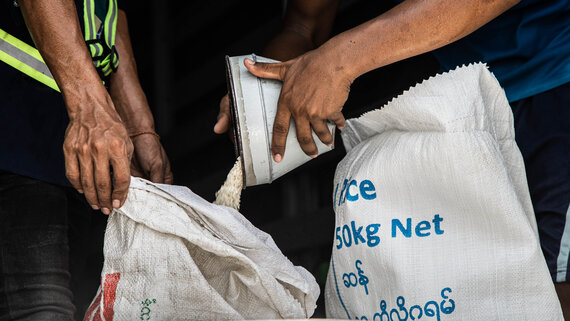
Yangon, Myanmar
WFP distributed rice to vulnerable families in Yangon's Hlaingtharyar Township in response to rising hunger following the military takeover on February.
WFPExtreme climatic and weather events drove almost 16 million people into food crises in 15 countries in 2020. Tropical storms, hurricanes, flooding and drought contributed to acute food insecurity in Central America and Haiti. Hurricanes Eta and Iota affected over 8.3 million people in northern and eastern Guatemala, northern Honduras and north-east Nicaragua.
In 2021, climate impacts joined conflict as a root cause of famine. This is evident in drought-affected Madagascar, where climate is driving famine-like conditions for approximately 28,000 people who faced IPC 5 levels of food insecurity in 2021. Acute food-insecurity of crisis-level has touched over 1.3 million people, including also 484,000 in Emergency IPC Phase 4. Delayed rains this planting season, signal another poor harvest and despair for families resorting to survival measures such as eating locusts, wild leaves and cactus leaves, which are usually fed to cattle.
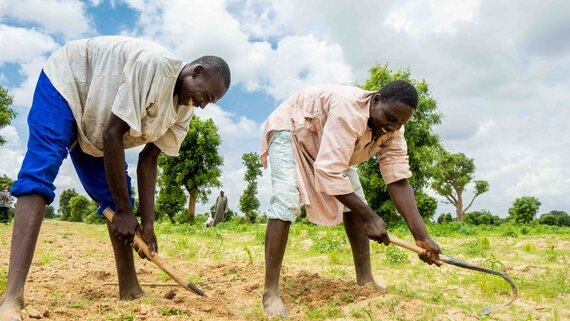
Gongulong, Nigeria
The violence forced these men and their family to leave Gongulong a few years ago to seek safety in Kano, then they returned to continue farming in their farm. Difference in patterns of rainfall and increased temperatures affects his farming and the local seeds take much longer time to grow. Climate change is affecting farmers and farming in North-Eeast Nigeria, contributing, among other factors like violence and insurgency, to food shortages. FAO in a joint effort with partner organizations, in response to climate change and rising temperatures, is providing improved seeds and trainings to farmers to help them continue to grow food and increase productivity.
OCHA/Damilola OnafuwaEconomic shocks following COVID-19 also had a negative impact on food crises in 2020. Indeed, more than 40 million people in 17 countries were pushed into acute food insecurity compared to 24 million in eight countries in 2019 – particularly in Haiti, Sudan and Zimbabwe.
Data from 2021 indicates an alarming overall increase in international food prices, pushing global food prices to their highest level in almost a decade. The FAO Food Price Index showed an increase of almost 40 per cent from the same period last year and the twelfth consecutive monthly rise to its highest level since September 2011.
The cost of a food basket is at least 30 per cent higher in 11 countries with an HRP than five years earlier. The cost is six times higher in Sudan (534 per cent) and in Syria (531 per cent), and almost three times higher in South Sudan (174 per cent). By the end of June 2021, almost 110 million people were suffering from acute food insecurity in countries with a HRP.
Evolution of the Food Price Index
Funding for food and livelihoods assistance needs to be scaled up urgently. Currently, the GHO’s food security sector is only 34 per cent funded and the nutrition sector less than 35 per cent funded. A stark imbalance remains in funding within the food security component of humanitarian assistance, with a significant proportion of resources directed to food assistance alone.
Without immediate and sustained humanitarian action, many more lives will be lost and millions of people will continue to face catastrophe next year, the effects of which will be felt for decades to come. We cannot afford to wait for famine declarations. The stakes have never been higher. Governments and humanitarian agencies saved millions of lives by taking early action in 2017 to prevent famine in north-east Nigeria, Somalia, South Sudan and Yemen. We have prevented famine before – we can and must prevent it again.
There is no time to waste; major planting seasons have already passed in 2021, robbing people of a valuable opportunity to produce their own supply of nutritious food. We must take advantage of every opportunity to safeguard livelihoods and save lives today and into 2022. In a world in which there is more than enough food to nourish every person on the planet, allowing famine to happen is cruel and a failure of compassion and foresight.
Further reading
Source: Food Security Information Network / Global Network Against Food Crises
Source: WFP
Source: Integrated Food Security Phase Classification
Source: FAO / WFP
Source: Global Food Security, Health, Nutrition, and WASH Clusters
References
- FAO, State of Food Security and Nutrition in the World 2021, (SOFI), p. 8. Considering the middle and the upper bound of the projected range, the prevalence of undernourishment increased from 8.4 to around 9.9 per cent in just one year. Africa reported the highest prevalence of undernourishment, affecting more than 282 million people across the region (21 per cent of the population). Close to a third of the world’s population did not have adequate access to food in 2020, a rise of 13.5 per cent in just one year. Women are the most at risk; compared to men they are 10 per cent more likely to be food insecure, a rise of 4 per cent on the previous year.
- This is a preliminary number, as not all countries covered in earlier years have updated numbers for 2021 available.
- Analysis focused on countries that requested external assistance and where most recent IPC/Cadre Harmonisé or equivalent data is available.
- IPC, IPC Overview and Classification System
- Covered by WFP monitoring systems
- WFP Global Operational Response Plan 2021, Update #3, November 2021
- Based on WFP operational presence and where data is available.
- WFP Global Operational Response Plan 2021 - Update #3, November 2021
- Global Report on Food Crises, September 2021
- According to the latest Integrated Food Security Phase Classification analysis published on 25 October 2021, 18.8 million people (47 per cent of the population) have acute food insecurity (IPC Phase 3 or above), which is a staggering 24 per cent increase from March. The IPC analysis forecasts that this number will rapidly increase to 22.8 million people from November 2021 to March 2022.
- IPC Central African Republic Alert, October 2021
- IPC Democratic Republic of the Congo Alert, November 2021
- Food Security Information Network, Global Report on Food Crises 2021, p. 22. DRC, Yemen, Afghanistan, Syria, Nigeria, and South Sudan.
- Food Security Information Network, Global Report on Food Crises 2021, p. 23.
- Food Security Information Network, Global Report on Food Crises 2021, p. 23.
- OCHA, COVID-19 Data Explorer: Global Humanitarian Operations, Monthly Highlights, 30 June 2021
- OCHA, COVID-19 Data Explorer: Global Humanitarian Operations, Monthly Highlights, 30 June 2021
- OCHA, COVID-19 Data Explorer: Global Humanitarian Operations, Monthly Highlights, 30 June 2021
- OCHA, COVID-19 Data Explorer: Global Humanitarian Operations, Monthly Highlights, 30 June 2021

